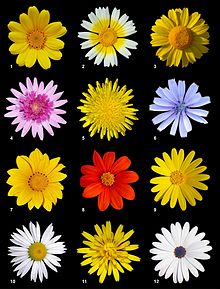Phytoalexins

Phytoalexins (Gr. Phytos = plant, alekein = "to ward off") are low molecular weight, antimicrobial and at least z. T. antioxidant effective chemical compounds that immediately after infection by microorganisms (such as bacteria or fungi to their propagation, growth or reproduction to inhibit are produced) by the plant in the plant. They can be detected in the affected plant tissues approx. 24 hours after infection and reach a maximum concentration after approx. Three days. It is important to mention here that the phytoalexins are only produced in the areas affected by microorganisms and in the immediate vicinity (a few mm). The substances that act as phytoalexins are a large number of compounds from various substance classes such as B. flavonoids , terpenoids , alkaloids , stilbenoids , polyacetylenes , isoflavones etc. Phytoalexins belong to the secondary plant substances .

1. Anthemis tinctoria (herbaceous),
second Glebionis coronaria ( herbaceous ),
3. Coleostephus myconis (herbaceous),
4. Chrysanthemum spec. (Herbaceous),
5. Sonchus oleraceus ( Cichorioideae )
6. Cichorium intybus (Cichorioideae)
7. Gazania rigens (Cichorioideae)
8. Tithonia rotundifolia (herbaceous),
9. Calendula arvensis (herbaceous),
10 Leucanthemum vulgare (Asteroideae ), 11. Hieracium lachenalii (Cichorioideae), 12. Osteospermum ecklonis (Asteroideae)
Phytoalexins were discovered in the 1940s on the basis of studies on the reaction of different potato varieties to pathogenic and non-pathogenic strains of the egg fungus Phytophthora sp. postulated and actually proven for the first time around 1960. In the meantime, several hundred different phytoalexins from more than 15 plant families are known, with most of the families producing more than one phytoalexin (partly also from different substance classes). Typically, the phytoalexins of a certain plant species belong to a substance class that is characteristic of the species or family anyway (i.e. it is also constitutively present). So find z. B. Polyacetylenes and sesquiterpene lactones in the Asteraceae , isoflavonoids in the Fabaceae , coumarins and polyacetylenes in the Apiaceae , phenanthrenes or stilbenes in the Orchidaceae , etc. Phytoalexins usually do not have a high specificity (with a few exceptions), but are quite the opposite non-specific effective against a large number of invading microorganisms. Phytoalexins must not be confused with other plant constituents that are available to the plant for defense against predators (insects, worms, grazing animals, etc.). This expression is only to be used for de novo formed substances for defense against microorganisms.
Phytoalexins are always only produced anew (de novo) after the penetration of microorganisms into plant tissue to defend them and are normally not detectable in healthy parts of the plant. In addition to microorganisms, the production of phytoalexins can also be triggered by a variety of other, including abiotic, factors such as: B. UV radiation, heavy metals, temperature shock, tissue damage, etc. This discovery also led to the fact that the original concept of Müller & Börger was completely softened and subsequently numerous plant ingredients were published as phytoalexins, which did not deserve this attribute because they often only induced by means of heavy metal salts and their antimicrobial properties have not been verified.
In any case, phytoalexins must be clearly distinguished from so-called constitutive plant defense substances (also called phytoanticipins ; e.g. mustard oil glycosides ), which the plant always keeps ready for defense and which are accumulated in various areas (glands, secretory ducts, vacuoles, etc.). Phytoalexins, on the other hand, are only produced when needed and in a narrowly limited area (only at the infection site) and, from an ecological or energetic point of view, offer the plant good protection with relatively little energy expenditure. However, this does not mean that phytoalexin-producing plants completely dispense with constitutive antibodies!
The plant uses so-called elicitors (including substances cut out of the cell wall of the attacking microorganisms by enzymes) as the start signal for the production of phytoalexins, which bind to receptors and transmit the information to the cell nucleus via a complex signal cascade. The elicitors recognized by the plant include polysaccharides and bacterial and fungal proteins and glycoproteins.
The biochemistry , genetics and evolution of phytoalexins are highly topical research areas.
literature
- WG Hopkins: Physiology végétale. ISBN 2-7445-0089-5 , 2003, De Boeck Université, p. 40.
- JB Harborne: Introduction to Ecological Biochemistry (1988), Academic Press Limited. ISBN 0-12-324683-0 , ISBN 0-12-324684-9 (paperback).
